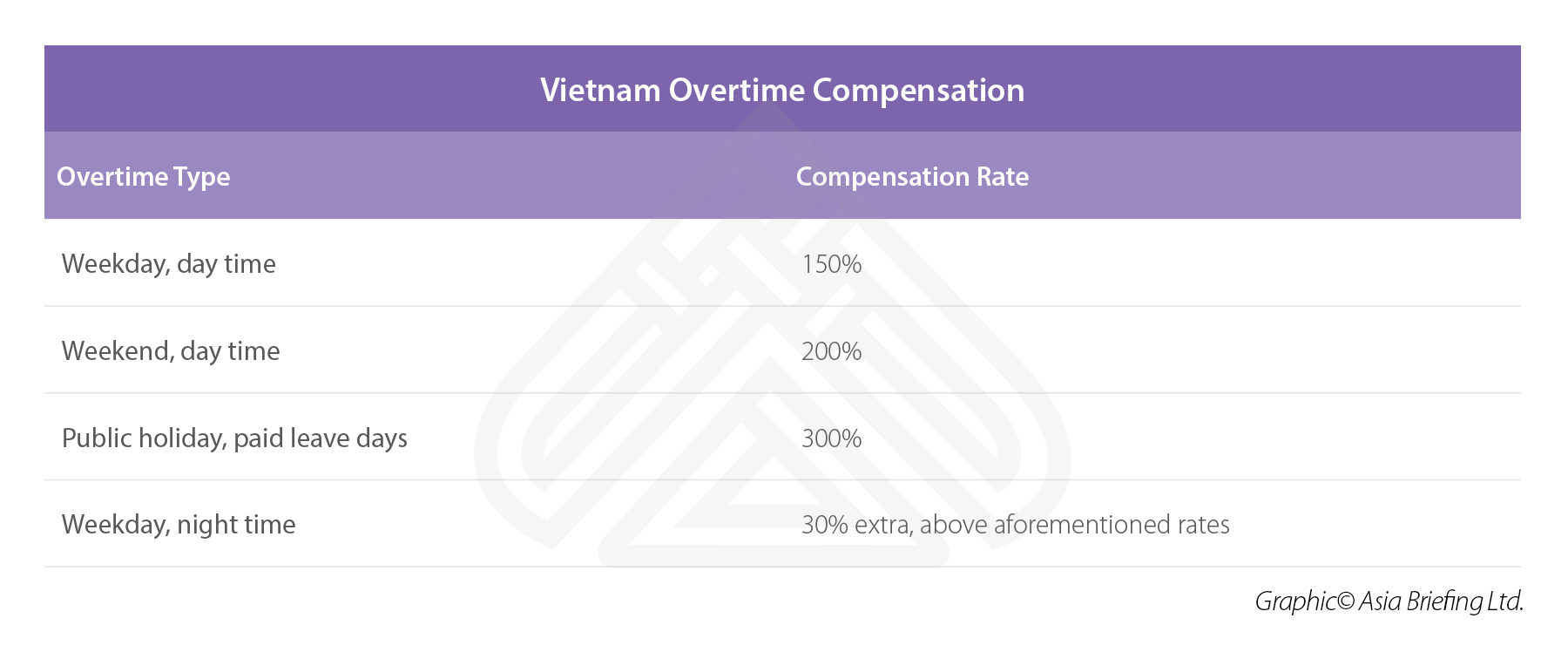Vietnam’s business environment, free trade costs, and its ideal location as a China plus one destination make it favorable among foreign investors looking to relocate or diversify their operations.
However, as Vietnam’s economy continues to grow, increasing wages will be an unavoidable feature of doing business in the country and is increasingly important for companies to understand how to navigate.
Vietnam increased the minimum wage by 6 percent starting in July 2024. This adjustment represents a compromise between the 6.48 to 7.3 percent requested by the Vietnam General Confederation of Labor and the 4.5 to 5 percent suggested by the Vietnam Chamber of Commerce and Industry. The hike came after a two-year hiatus in minimum wage adjustments despite rising inflation rates, which may necessitate further increases shortly.
What are the minimum wage rates in Vietnam?
There are two kinds of minimum wages in Vietnam.
The first type is the common minimum wage of VND 2,340,000 (US$93) which is used to calculate salaries for employees in state-owned organizations and enterprises, as well as to calculate the social contribution for all enterprises (i.e., the maximum social contribution is 20 times the common minimum wage).
The second type of minimum wage is the Regional Minimum Wage used for employees in all non-state enterprises based on zones as defined by the government.
|
|
Current (2022) |
Change (6%) |
New (2024) |
||||||||||||||||||||||||||||||||||||||||||||||||||||||||||||||||||||||||||||||||||||||||||||||||||||||||||||||||||||||||||||||||||||||||||||||||||||||||||||||||||||||||||||||||||||||||||||||||||||||||||||||||||||||||||||||||||||||||||||||||||||||||||||||||||||||||||||||||||||||||||||||||||||||||||||||||||||||||||||||||||||||||||||||||||||||||||||||||||||||||||||||||||||||||||||||||||||||||||||||||||||||||||||||||||||||||||||||||||||||||||||||||||||||||||||||||||||||||||||||||||||||||||||||||||||||||||||||||||||||||||||||||||||||||||||||||||||||||||||||||||||||||||||||||||||||||||||||||||||||||||||||||||||||||||||||||||||||||||||||||||||||||||||||||||||||||||||||||||||||||||||||||||||||||||||||||||||||||||||||||||||||||||||||||||||||||||||||||||||||||||||||||||||||||||||||||||||||||||||||||||||||||||||||||||||||||||||||||||||||||||||||||||||||||||||||||||||||||||||||||||||||||||||||||||||||||||||||||||||||||||||||||||||||||||||||||||||||||||||||||||||||||||||||||||||||||||||||||||||
|
Region |
VND |
US$ |
VND |
US$ |
VND |
US$ |
|||||||||||||||||||||||||||||||||||||||||||||||||||||||||||||||||||||||||||||||||||||||||||||||||||||||||||||||||||||||||||||||||||||||||||||||||||||||||||||||||||||||||||||||||||||||||||||||||||||||||||||||||||||||||||||||||||||||||||||||||||||||||||||||||||||||||||||||||||||||||||||||||||||||||||||||||||||||||||||||||||||||||||||||||||||||||||||||||||||||||||||||||||||||||||||||||||||||||||||||||||||||||||||||||||||||||||||||||||||||||||||||||||||||||||||||||||||||||||||||||||||||||||||||||||||||||||||||||||||||||||||||||||||||||||||||||||||||||||||||||||||||||||||||||||||||||||||||||||||||||||||||||||||||||||||||||||||||||||||||||||||||||||||||||||||||||||||||||||||||||||||||||||||||||||||||||||||||||||||||||||||||||||||||||||||||||||||||||||||||||||||||||||||||||||||||||||||||||||||||||||||||||||||||||||||||||||||||||||||||||||||||||||||||||||||||||||||||||||||||||||||||||||||||||||||||||||||||||||||||||||||||||||||||||||||||||||||||||||||||||||||||||||||||||||||||||||||||||
|
1 |
4,680,000 |
192.33 |
280,800 |
11.54 |
4,960,000 |
196 |
|||||||||||||||||||||||||||||||||||||||||||||||||||||||||||||||||||||||||||||||||||||||||||||||||||||||||||||||||||||||||||||||||||||||||||||||||||||||||||||||||||||||||||||||||||||||||||||||||||||||||||||||||||||||||||||||||||||||||||||||||||||||||||||||||||||||||||||||||||||||||||||||||||||||||||||||||||||||||||||||||||||||||||||||||||||||||||||||||||||||||||||||||||||||||||||||||||||||||||||||||||||||||||||||||||||||||||||||||||||||||||||||||||||||||||||||||||||||||||||||||||||||||||||||||||||||||||||||||||||||||||||||||||||||||||||||||||||||||||||||||||||||||||||||||||||||||||||||||||||||||||||||||||||||||||||||||||||||||||||||||||||||||||||||||||||||||||||||||||||||||||||||||||||||||||||||||||||||||||||||||||||||||||||||||||||||||||||||||||||||||||||||||||||||||||||||||||||||||||||||||||||||||||||||||||||||||||||||||||||||||||||||||||||||||||||||||||||||||||||||||||||||||||||||||||||||||||||||||||||||||||||||||||||||||||||||||||||||||||||||||||||||||||||||||||||||||||||||||
|
2 |
4,160,000 |
170.96 |
249,600 |
10.26 |
4,410,000 |
175 |
|||||||||||||||||||||||||||||||||||||||||||||||||||||||||||||||||||||||||||||||||||||||||||||||||||||||||||||||||||||||||||||||||||||||||||||||||||||||||||||||||||||||||||||||||||||||||||||||||||||||||||||||||||||||||||||||||||||||||||||||||||||||||||||||||||||||||||||||||||||||||||||||||||||||||||||||||||||||||||||||||||||||||||||||||||||||||||||||||||||||||||||||||||||||||||||||||||||||||||||||||||||||||||||||||||||||||||||||||||||||||||||||||||||||||||||||||||||||||||||||||||||||||||||||||||||||||||||||||||||||||||||||||||||||||||||||||||||||||||||||||||||||||||||||||||||||||||||||||||||||||||||||||||||||||||||||||||||||||||||||||||||||||||||||||||||||||||||||||||||||||||||||||||||||||||||||||||||||||||||||||||||||||||||||||||||||||||||||||||||||||||||||||||||||||||||||||||||||||||||||||||||||||||||||||||||||||||||||||||||||||||||||||||||||||||||||||||||||||||||||||||||||||||||||||||||||||||||||||||||||||||||||||||||||||||||||||||||||||||||||||||||||||||||||||||||||||||||||||
|
3 |
3,640,000 |
149.59 |
218,400 |
8.98 |
3,860,000 |
153 |
|||||||||||||||||||||||||||||||||||||||||||||||||||||||||||||||||||||||||||||||||||||||||||||||||||||||||||||||||||||||||||||||||||||||||||||||||||||||||||||||||||||||||||||||||||||||||||||||||||||||||||||||||||||||||||||||||||||||||||||||||||||||||||||||||||||||||||||||||||||||||||||||||||||||||||||||||||||||||||||||||||||||||||||||||||||||||||||||||||||||||||||||||||||||||||||||||||||||||||||||||||||||||||||||||||||||||||||||||||||||||||||||||||||||||||||||||||||||||||||||||||||||||||||||||||||||||||||||||||||||||||||||||||||||||||||||||||||||||||||||||||||||||||||||||||||||||||||||||||||||||||||||||||||||||||||||||||||||||||||||||||||||||||||||||||||||||||||||||||||||||||||||||||||||||||||||||||||||||||||||||||||||||||||||||||||||||||||||||||||||||||||||||||||||||||||||||||||||||||||||||||||||||||||||||||||||||||||||||||||||||||||||||||||||||||||||||||||||||||||||||||||||||||||||||||||||||||||||||||||||||||||||||||||||||||||||||||||||||||||||||||||||||||||||||||||||||||||||||
|
4 |
3,250,000 |
133.56 |
195,000 |
8.01 |
3,450,000 |
137 |
|||||||||||||||||||||||||||||||||||||||||||||||||||||||||||||||||||||||||||||||||||||||||||||||||||||||||||||||||||||||||||||||||||||||||||||||||||||||||||||||||||||||||||||||||||||||||||||||||||||||||||||||||||||||||||||||||||||||||||||||||||||||||||||||||||||||||||||||||||||||||||||||||||||||||||||||||||||||||||||||||||||||||||||||||||||||||||||||||||||||||||||||||||||||||||||||||||||||||||||||||||||||||||||||||||||||||||||||||||||||||||||||||||||||||||||||||||||||||||||||||||||||||||||||||||||||||||||||||||||||||||||||||||||||||||||||||||||||||||||||||||||||||||||||||||||||||||||||||||||||||||||||||||||||||||||||||||||||||||||||||||||||||||||||||||||||||||||||||||||||||||||||||||||||||||||||||||||||||||||||||||||||||||||||||||||||||||||||||||||||||||||||||||||||||||||||||||||||||||||||||||||||||||||||||||||||||||||||||||||||||||||||||||||||||||||||||||||||||||||||||||||||||||||||||||||||||||||||||||||||||||||||||||||||||||||||||||||||||||||||||||||||||||||||||||||||||||||||||
In addition, the labor code also ensures minimum hourly wage rates for the relevant regions. These are:
- Region I – VND 23,800 (US$0.94)
- Region II – VND 21,200 (US$0.84)
- Region III – VND 18,600 (US$0.74)
- Region IV – VND 16,600 (US$0.66)
Wages for employees who are paid daily or on a weekly basis must not be lower than the minimum wage when converted to monthly or hourly rates.
Who is eligible?
The wage increase applies to employees who work under labor contracts under the labor code, including businesses, organizations, cooperatives, households, and individuals who hire employees on labor contracts.
List of regional administrative units in Vietnam
Region I
- Urban and rural districts of Hanoi City, including: Gia Lam, Dong Anh, Soc Son, Thanh Tri, Thuong Tin, Hoai Duc, Thach That, Quoc Oai, Thanh Oai, Me Linh, and Chuong My, and Son Tay Town;
- Cities and district-level towns of Quang Ninh Province, including: Ha Long, Uong Bi, Mong Cai, Quang Yen and Dong Trieu;
- Urban and rural districts of Hai Phong City, including: Thuy Nguyen, An Duong, An Lao, Vinh Bao, Tien Lang, Cat Hai and Kien Thuy;
- Hai Duong City of Hai Duong Province;
- Urban districts, Thu Duc City, and other rural districts of Ho Chi Minh City, including: Cu Chi, Hoc Mon, Binh Chanh and Nha Be;
- Bien Hoa City, Long Khanh City and other rural districts of Dong Nai Province, including: Nhon Trach, Long Thanh, Vinh Cuu, Trang Bom, Xuan Loc and Thong Nhat;
- Cities and rural districts of Binh Duong Province, including: Thu Dau Mot, Thuan An, Di An, Tan Uyen, Ben Cat, Bau Bang, Bac Tan Uyen, Dau Tieng and Phu Giao;
- Vung Tau City and Phu My Town of Ba Ria – Vung Tau Province;
- Tan An City and rural districts of Long An Province, including: Duc Hoa, Ben Luc, and Can Giuoc.
Region II
- Remaining rural districts of Hanoi City;
- Lao Cai City of Lao Cai Province;
- Thai Nguyen City, Song Cong City and Pho Yen City of Thai Nguyen Province;
- Hoa Binh City and Luong Son rural district of Hoa Binh Province;
- Viet Tri City of Phu Tho Province;
- Bac Giang City, Viet Yen Town and Yen Dung rural district of Bac Giang Province;
- Vinh Yen City, Phuc Yen City, and two rural districts of Vinh Phuc Province, including Binh Xuyen and Yen Lac;
- Bac Ninh City, Tu Son City, Thuan An Town, Que Vo Town, and other rural districts of Bac Ninh Province, including: Tien Du, Yen Phong, Gia Binh and Luong Tai;
- Hung Yen City, My Hao Town and other rural districts of Hung Yen Province, including: Van Lam, Van Giang and Yen My;
- Chi Linh City, Kinh Mon Town, and other rural districts of Hai Duong Province, including: Cam Giang, Binh Giang, Tu Ky, Gia Loc, Nam Sach, and Kim Thanh;
- Cam Pha City of Quang Ninh Province;
- Remaining rural districts of Hai Phong City;
- Thai Binh City of Thai Binh Province;
- Nam Dinh City and My Loc rural district of Nam Dinh Province;
- Ninh Binh City of Ninh Binh Province;
- Thanh Hoa City, Sam Son City and two district-level towns of Thanh Hoa Province, including: Bim Son and Nghi Son;
- Vinh City, Cua Lo Town and two rural districts of Nghe An Province, including Nghi Loc and Hung Yen;
- Dong Hoi City of Quang Binh Province;
- Hue City of Thua Thien Hue Province;
- Hoi An City and Tam Ky City of Quang Nam Province;
- Urban and rural districts of Da Nang City;
- Nha Trang City, Cam Ranh City and Ninh Hoa Town of Khanh Hoa Province;
- Da Lat City and Bao Loc City of Lam Dong Province;
- Phan Thiet City of Binh Thuan Province;
- Can Gio rural district of Ho Chi Minh City;
- Tay Ninh City, Trang Bang Town, Hoa Thanh Town, and Go Dau rural district of Tay Ninh Province;
- Rural districts of Dong Nai Province, including Dinh Quan, Tan Phu and Cam My;
- Dong Xoai City, Chon Thanh Town and Dong Phu rural district of Binh Phuoc Province;
- Ba Ria City of Ba Ria – Vung Tau Province;
- Kien Tuong Town and two rural districts of Long An Province, including: Thu Thua and Can Duoc;
- My Tho City and Chau Thanh rural district of Tien Giang Province;
- Ben Tre City and Chau Thanh rural district of Ben Tre Province;
- Vinh Long City and Binh Minh Town of Vinh Long Province;
- Urban districts of Can Tho City;
- Rach Gia City, Ha Tien City and Phu Quoc City of Kien Giang Province;
- Long Xuyen City and Chau Doc City of An Giang Province;
- Tra Vinh City of Tra Vinh Province;
- Soc Trang City of Soc Trang Province;
- Bac Lieu City of Bac Lieu Province;
- Ca Mau City of Ca Mau Province.
Region III
- Remaining provincial cities (except provincial cities of region I and region II);
- Sa Pa Town and Bao Thang rural district of Lao Cai Province;
- Rural districts of Thai Nguyen Province, including: Phu Binh, Phu Luong, Dong Hy and Dai Tu;
- Rural districts of Bac Giang Province, including: Hiep Hoa, Tan Yen and Lang Giang;
- Rural districts of Hai Duong Province, including: Ninh Giang, Thanh Mien and Thanh Ha;
- Phu Tho Town and rural districts of Phu Tho Province, including: Phu Ninh, Lam Thao, Thanh Ba and Tam Nong;
- Rural districts of Vinh Phuc Province, including: Vinh Tuong, Tam Dao, Tam Duong, Lap Thach and Song Lo;
- Rural districts of Quang Ninh Province, including: Van Don, Hai Ha, Dam Ha and Tien Yen;
- Remaining rural districts of Hung Yen Province;
- Two rural districts of Thai Binh Province, including: Thai Thuy and Tien Hai;
- Remaining rural districts of Nam Dinh Province;
- Duy Tien Town and Kim Bang rural district of Ha Nam Province;
- Rural districts of Ninh Binh Province, including: Gia Vien, Yen Khanh and Hoa Lu;
- Rural districts of Thanh Hoa Province, including: Dong Son, Quang Xuong, Trieu Son, Tho Xuan, Yen Dinh, Vinh Loc, Thieu Hoa, Ha Trung, Hau Loc, Nga Son, Hoang Hoa, and Nong Cong;
- Rural districts and district-level towns of Nghe An Province, including: Quynh Luu, Yen Thanh, Dien Chau, Do Luong, Nam Dan, Nghia Dan, Thai Hoa and Hoang Mai;
- Ky Anh Town of Ha Tinh Province;
- Huong Thuy Town, Huong Tra Town and rural districts of Thua Thien Hue Province, including: Phu Loc, Phong Dien, Quang Dien and Phu Vang;
- Dien Ban Town and rural districts of Quang Nam Province, including: Dai Loc, Duy Xuyen, Nui Thanh, Que Son, Thang Binh and Phu Ninh;
- Two rural districts of Quang Ngai Province, including: Binh Son and Son Tinh;
- Song Cau Town and Dong Hoa Town of Phu Yen Province;
- Rural districts of Ninh Thuan Province, including: Ninh Hai, Thuan Bac and Ninh Phuoc;
- Rural districts of Khanh Hoa Province, including: Cam Lam, Dien Khanh and Van Ninh;
- Dak Ha rural district of Kon Tum Province;
- Two rural districts of Lam Dong Province, including Duc Trong and Di Linh;
- La Gi Town and two rural districts of Binh Thuan Province, including Ham Thuan Bac and Ham Thuan Nam;
- Phuoc Long Town, Binh Long Town and rural districts of Binh Phuoc Province, including: Hon Quan, Loc Ninh and Phu Rieng;
- Remaining rural districts of Tay Ninh Province;
- Rural districts of Ba Ria - Vung Tau Province, including: Long Dien, Dat Do, Xuyen Moc, Chau Duc and Con Dao;
- Rural districts of Long An Province, including: Duc Hue, Chau Thanh, Tan Tru and Thanh Hoa;
- Cai Lay Town, and two rural districts of Tien Giang Province, including Cho Gao and Tan Phuoc;
- Rural districts of Ben Tre Province, including: Ba Tri, Binh Dai and Mo Cay Nam;
- Two rural districts of Vinh Long Province, including: Mang Thit and Long Ho;
- Rural districts of Can Tho City;
- Rural districts of Kien Giang Province, including: Kien Luong, Kien Hai and Chau Thanh;
- Tan Chau Town and rural districts of An Giang Province, including: Chau Phu, Chau Thanh and Thoai Son;
- Rural districts of Hau Giang Province, including Chau Thanh and Chau Thanh A;
- Duyen Hai Town of Tra Vinh Province;
- Gia Rai Town and Hoa Binh rural district of Bac Lieu Province;
- Vinh Chau Town and Nga Nam Town of Soc Trang Province;
- Rural districts of Ca Mau Province, including: Nam Can, Cai Nuoc, U Minh and Tran Van Thoi;
- Rural districts, including Le Thuy, Quang Ninh, Bo Trach and Quang Trach, and Ba Don Town of Quang Binh Province.
Region IV
Region IV includes the remaining subregions
How are minimum wage rates applied?
All contracts must use the minimum wage rates as the lowest amount of compensation for any commercial arrangement between an employer and an employee. Companies should ensure that the correct wage rate is applied, especially in certain special circumstances, including:
- If the company has any branches or affiliate companies in a different subregion, the region-based minimum wage will be applied to all employees of those offices.
- For companies located in an industrial park or the export processing zone that spans two or more, the highest minimum wage rate will apply.
Salary components
In general, an employee’s typical monthly salary package includes their gross salary and mandatory insurance contributions. Personal income taxes (PIT) will be levied on the balance after mandatory insurance contributions have been deducted.
In some cases, the gross salary may also include overtime pay, allowances, and bonuses, as well as additional benefits.
Further, Vietnamese employees must receive compensation in Vietnamese Dong, even if they work for foreign companies. Foreign employers can only base salary rates in either Vietnamese Dong or foreign currencies for foreign employees, but salaries that are based in foreign currencies must be converted into Vietnamese Dong for compulsory social insurance, personal income tax, and trade union pay. The exchange rate is based on the Vietnamese governments' foreign exchange.
Are employees eligible for overtime pay in Vietnam?
Employee consent must be obtained if the employer plans overtime work regarding the terms, locations, and overtime work. Employees who work extra hours are also paid for those extra hours based on their current hourly wages, as outlined above.
In cases where an employee works overtime hours at night, they are paid extra according to the applicable regulations. Further, employees who are given time off in compensation for working extra hours should be paid the difference between their wages during normal working hours and overtime work. Finally, employees who work night shifts should be paid at least 30 percent higher than normal.
In general, an employee’s typical monthly salary package includes their gross salary and mandatory insurance contributions. Personal income taxes (PIT) will be levied on the balance after mandatory insurance contributions have been deducted.
Overtime compensation
If a company triggers overtime, they will be obligated to compensate employees beyond the wages that are outlined in their contract. This is applicable to all employees regardless of the wages that are offered. The following are the percentages in excess of the standard that are to be applied in the event that certain work-related thresholds are crossed.

There are limitations on the number of overtime hours an employee is allowed to work. As per the labor code, overtime hours cannot exceed 40 hours per month. The code also supplements cases where employers are permitted to organize overtime work for up to 300 hours per year; these include manufacturing and exporting electrical and electronic products as well as work requiring high technical qualifications.
If the employer and employee agree on an overtime deal, employers are permitted to assign their employees to work overtime for over 200 hours but not exceeding 300 hours per year, except in the following cases:
- Employees aged between 15 and under 18;
- Employees having mild disabilities with work capacity reduction of at least 51% or employees with severe disabilities or extremely severe disabilities;
- Employees doing arduous, hazardous, dangerous or extremely arduous, hazardous or dangerous work;
- Female employees in their 7th month of pregnancy onward (or the 6th month of pregnancy onward in case they work in the highlands, remote areas, bordering areas, or islands);
- Female employees nursing children aged under 12 months.

In cases where an employee works extra hours at night, they are paid extra in accordance with the applicable regulations. Further, employees who are given time off in compensation for working extra hours will need to be paid the difference between their wages during normal working hours and overtime work. Finally, employees who work night shifts should be paid at least 30 percent higher than normal.
There are special situations which may trigger other regulations within the code for overtime:
- Pregnant women: Women who are in their 7th month of pregnancy and women with babies under 12 months are not allowed to work overtime, work at night, or take long-distance business trips. Pregnant women who are performing heavy work must either be transferred to lighter work or decrease daily work time by an hour while maintaining the same total pay.
- Minor employees:
- Workers under the age of 18: Prohibited from working in dangerous conditions or with potential exposure to toxic substances. The Ministry of Labor, Invalids and Social Affairs (MoLISA) also establishes a limit on which industries and what kind of work minors can undertake.
- Minor employees between the ages of 15 and 18: May work a maximum of eight hours a day and 40 hours a week. They are only permitted to do overtime and night work in certain industries, as specified by the Ministry.
- Workers under the age of 15: Regulations establish a maximum of four hours a day and 20 a week, with no overtime or night work permitted. Working hours for those under 13 years of age are further reduced to one hour per day.
Performance and earnings-based bonuses for employees
Bonuses are given to employees based on company earnings and performance and as a way of boosting company morale and productivity. There are various kinds of bonuses that a company may grant its employees throughout the year.
All salaries and bonuses are subject to PIT in Vietnam.
13th-month salary
A 13th month’s salary is usually given as an “annual bonus” by both local and foreign companies in Vietnam to employees who have worked with the company for at least one year. Employees who have worked at a company for less than one year are typically given a bonus that is prorated and based on their actual employment period.
Lunar New Year or Tet bonus
A special bonus called the “Lunar New Year” bonus (or “Tet Bonus”) is often paid to employees prior to their leaving for the Lunar New Year holiday.
The amount of any Tet Bonus will be dependent on both company and employee performance but typically ranges from smaller amounts of money (up to an entire month’s salary) to larger amounts of money (up to an entire year’s salary) depending on the company's progress and goals.
Additional bonuses
Employees may also be given smaller bonuses for public holidays or other special days (e.g., International Labor Day or National Day). Senior management and other valued employees may be given bonuses during these days as well, including in the form of share certificates with a vesting period, for which the corresponding stock can be sold only after the employee has worked for the company for a certain amount of time.
Allowances and benefits
An employee may be entitled to several kinds of allowances and monetary or non-monetary benefits designed to retain staff. Some of these benefits are non-taxable, including:
- Payments for housing rent, power, water, and associated services for employees that amount to more than 15 percent of their total taxable income;
- Life insurance and optional insurance;
- Payment for a membership card, which does not include the user's name, of golf clubs, tennis courts, and other exclusive clubs;
- Payment for a membership card, which does not include the user's name, of health care, entertainment, etc. services;
- Telephone allowance;
- Stationery allowance;
- Uniform allowance in kind or in cash not exceeding 5 million VND;
- Lunch allowance not exceeding 730,000 VND;
- Funeral payment not exceeding any month's actual salary in the year;
- Wedding payment not exceeding any month's actual salary in the year;
- Transportation allowances;
- Training allowances;
- Employer support for fatal disease or illness;
- Round-trip flight ticket to return home country once a year for foreign employees or Vietnamese employees working abroad;
- Tuition fees for children of foreign workers working in Vietnam study in Vietnam, children of Vietnamese workers working abroad study overseas from kindergarten to high school;
- Personal incomes received from any associations and organizations if the employees receiving the grant are members of these associations and organizations and these associations and organizations’ funding is used from the State budget or managed according to the State's regulations;
- Payments paid by the employer for the deployment, rotating foreign workers to work in Vietnam according to regulations in the labor contract, and complying with the standard labor schedule according to the international practices of some industries such as oil and gas and mining.
Prefixed lump sum amounts (or “khoan chi” amounts) for telephone calls and services, stationery, uniforms, and per diem allowances are not subject to taxes if the amounts are within the levels set out under the relevant regulations.
Foreigners who work in Vietnam are also exempted from PIT on various benefits such as relocation allowances for moving into the country, airfare to their home country, and education fees for their children.





















